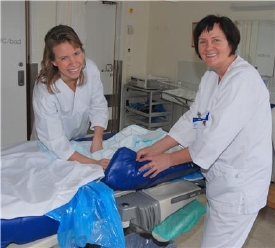Sep 14 2009
Astrid Skreosen has worked for many years as an auxiliary nurse in the maternity ward in Skien Hospital. She became fed up with the little mats which were supposed to lie under women who were giving birth, and were intended to soak up waste products and fluids. “Restless women in labour and unstable mats made problems for everyone. None of these underlays fitted the delivery beds, and we were wading in foetal fluids and blood. I was just as irritated by people who said that we shouldn’t complain, but just make the best of things,” says Skreosen, who decided to do something about the problem herself.
 Astrid Skreosen (left) used to work in the maternity ward in Skien Hospital. Now she is developing medical aids for her former work-place. The photo shows her together with colleague Elin Tollefsen.
Astrid Skreosen (left) used to work in the maternity ward in Skien Hospital. Now she is developing medical aids for her former work-place. The photo shows her together with colleague Elin Tollefsen.
She began to look into the possibility of producing a specially modified super-absorbent bed sheet, and after stumbling around in the dark for a while with inventors’ consultants and patent offices, she rang SINTEF.
Skreosen was put in touch with Per Stenstad in SINTEF Materials and Chemistry. After a few meetings an agreement to cooperate was signed. By Christmas 2007 the plans were so advanced that she could apply for funding and set up a company: ASAP Norway.
Triple-layer, millimetre-thick sheet
“The principle of an absorbent polymer material is well known”, says Stenstad. “It functions rather like a nappy. In this case, the challenge was that the sheet must be only a millimetre thick, without letting dampness pass through it. The set of sheets also had to consist of two parts in order to be suitable for the labour bed.”
SINTEF scientists have already developed two prototypes and a number of other textiles that have been tested; Ullevål Hospital in Oslo is interested. The products are made up of three layers: the bottom layer acts as a humidity barrier while the mid-layer is a superabsorbent polymer, topped by a gauze-like layer in contact with the skin; this is intended to allow fluids to pass rapidly through it.
“We carried out a survey of damp-absorbent polymers in use today; for example in nappies. Most of these are based on polyacrylic acid, and we have used a powder that is based on this powder. We have managed to produce prototypes that are only 0.1 mm thick by fixing a thin layer of absorbent powder directly to the base layer,” says Stenstad.
For the base layer itself, the scientists found a suitable bioplastic from BioBag. It is soft, flexible and environmentally friendly, and the project group is already in contact with the manufacturer, who is positive about signing an agreement to produce the material.
SINTEF health researchers have been responsible for concept development and prototype development.
“It was important to end up with a bed sheet that utilises simple and functional technology, that would also ensure maximum absorption of damp,” says one of them, Tore Christian Storholmen.
Savings
Astrid Skreosen has applied for a patent, and is now looking for a company to produce her sheets.
“This bed sheet can be used in maternity wards and in field hospitals anywhere in the world. Another option would be to use it in operating theatres and ambulances,” she says.
The aim is to enable hospitals to save time and money by using the new sheet. Clearing up and laundering after a delivery is a major, time-consuming job, and lack of time for such tasks can lead to infections. Replacing the mats with a sheet of this type will also mean less waste.”